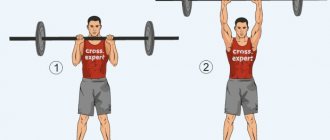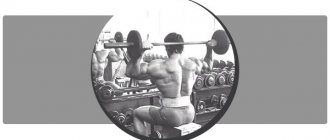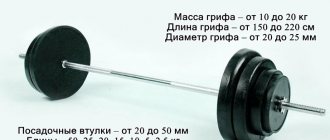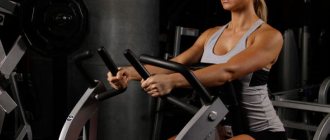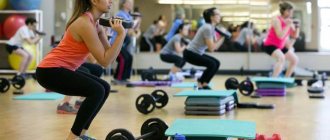We think you know: you can put an equal sign between progress in muscle mass and progress in weights. But what to do if your working weight does not increase ? Of course, it is possible that you have reached the limit of your capabilities and then you should bet on more repetitions, but what if this is not the case? And, for example, in the wrong training scheme, the size of the bar, or the weakness of other muscles? In this case, we have 6 tips with which you can press more.
#1 Train other muscle groups
Problem
The bench press is a basic exercise, which means that other muscle groups are involved in it in addition to the pectoral ones. Among them are triceps and anterior delta . If they are poorly developed, this will affect your working weight and the number of repetitions.
For example, if your triceps are poorly developed, it will be difficult for you to press the weight to the top point at the end of the movement path. If the deltoids lag behind, then difficulties will arise with holding the barbell in one plane, which means it will “walk.”
Solution
Focus on training your triceps and deltoids . Don't forget about the Arnold press, military press, French bench press, dips and other exercises for these muscle groups.
Typical beginner mistakes
Along with the bench press, deadlift and squats with a barbell on the shoulders, the military press is an exercise that can not only contribute to the all-round development of the athlete, but also cause irreparable harm to health, and recovery from the injury can take more than one month. Therefore, if you recognize yourself in one of the points described below, you should reconsider your military press technique, starting from the very basics, and even better, do not repeat your mistakes and seek help from an experienced, highly qualified instructor.
Neglecting warm-up
Before performing a classic standing barbell press, due attention should be paid to joint warm-up; shoulders, hands and elbows should be thoroughly warmed up and prepared for work. If your working weight in the military press is high enough, take the time to perform several warm-up approaches, starting with an empty bar and gradually increasing the weight of the apparatus. It is also recommended to stretch the triceps separately, since it receives a decent load in this exercise; several sets of extensions from the upper block with light weight will only be beneficial.
Too much weight
The standing barbell press is an excellent accessory exercise for the bench press, but even it is not recommended to work in a very low repetition range and with a huge weight. If you lift a weight that is too heavy, you lose almost all the benefits of doing this exercise, since you do not have time to put enough stress on the deltoids (shoulders do not like work in low rep ranges; our deltoids and shoulder joints are simply not designed for strength work). You also overload the rotator cuff and ligaments of the shoulders, elbows and hands, which can lead to injury.
Cheating
In such traumatic exercises, you should never deviate from the correct technique in favor of heavier weights or more repetitions. By including additional muscle groups (legs, lower back), you not only reduce the effectiveness of the standing barbell press, since the shoulders receive less load, but you also risk serious spinal injury due to severe compression of the intervertebral discs in the lumbar region.
Fixation at the top point
You should not fixate at the top point for more than a few seconds - this will increase the axial load on the spine significantly, as in squats with a barbell overhead.
Incorrect position of the bar
The projectile should be located on the chest or in close proximity to it and the collarbones. If the barbell is brought forward too much, the shoulder joint moves a little forward, and the position of the elbow is also unstable. Doing a military press in this position, I give a 99% guarantee that you will get injured.
Choose the right shoes
Take this point seriously, remember that your legs are your foundation, and the entire result depends on how strong and stable it is. If you find it difficult to maintain balance during the approach, try changing your training shoes; it is best to use sneakers with a rigid sole without a heel or instep.
Don't experiment with overhead presses
If you have mastered the correct technique of the military press and have developed a good neuromuscular connection in it, leave this shoulder exercise as the main one in your arsenal, do not try to replace it with the barbell overhead press. The load in these two exercises is almost the same, the main part of it falls on the anterior delta, but when pressing from behind the head, the shoulder joint is fixed in an unnatural position, due to which it is often subject to injury.
Video from Alexey Nemtsov about common mistakes beginners make when performing standing barbell presses:
#2 Focus on your breathing technique
Problem
One of the most difficult parts of the trajectory is the “dead spot”. We think you remember how you felt when you encountered her. The speed of movement of the projectile slows down, it is more difficult for you to work with the weight, and on the last repetitions you get the feeling that you cannot overcome it. But this feeling may be an illusion: holding your breath for a short time .
This technique will help increase intra-abdominal pressure and core stability, which will help you do more reps or add a few pounds to your working weight.
Solution
Try to hold your breath as you pass the “dead point.” Here's what the breathing technique will look like in this case:
- When lowering the weight, take a deep breath
- At the lowest point before lifting the barbell, hold your breath
- Continue holding your breath until the projectile passes the "dead spot"
- After the “dead point”, exhale
The technique is recommended only for advanced athletes without health problems. The breath hold should be short. Before using this breathing technique, consult a trainer.
#3 Experiment with grip width
Lifehack
The position of your hands can affect the number of repetitions and the weight you work. The reason for this is that different hand positions place stress on different muscle groups. Tapered - for triceps. The wider one is for the chest. Some muscle groups may be more developed, and therefore changing your position can affect your performance.
But that is not all. The most effective grip width depends on the length of your arms, so experimenting with it makes sense.
Solution
Experiment with your grip and find out what type of technique will make your presses more effective . It is quite possible that changing your grip width will give you a few extra reps or kilograms on the barbell.
#4 Give exercise a priority
Problem
One of the problems with poor performance in the bench press is that many people put the exercise in the middle, or even the end of the workout. The muscles become very tired by the time the exercise starts, which affects strength indicators.
Solution
Place bench presses at the beginning of your workout, but don’t forget to warm up before them. If you train your pecs in a split with triceps or deltoids, the rule is the same. Don't forget: the bench press works both muscle groups , and there is no point in tiring you in advance.
Training programs
The military press is added to the beginning of shoulder training. As a rule, they are trained either on a separate day or with legs.
The most popular split programs:
| Shoulders on a separate day | |
| Exercise | Sets x reps |
| Standing barbell press | 4х15,12,10,8 |
| Seated dumbbell press | 4x12 |
| Wide grip pull | 4x12 |
| Dumbbell swings while standing to the sides | 3x15 |
| Bent over dumbbell swings | 4x15 |
| Arm raises in the rear deltoid machine | 4x15 |
| Legs+shoulders | |
| Exercise | Sets x reps |
| Squats | 4х12,10,8,6 |
| Leg press in the simulator | 3x12 |
| Bending in a lying machine | 4x15 |
| Bend one leg while standing in the simulator | 4x12 |
| Standing barbell press | 4х15,12,10,8 |
| Wide grip pull | 4x15 |
| Side bend swings | 4x15 |
Recipes for healthy eating
Chicken breasts stewed with vegetables
- 8.6 g Protein
- 2.4 g Fat
- 13.6 g Carbohydrates
- 112.3 kcal
30-35 min.
- #bell pepper
- #second course
- #dietary
- #chicken breast
- #low calorie
- #dinner
- #roasting
- #olive oil
- #soy sauce
- #green beans
- #dinner
Other recipes
#5 Change the neck size
Problem
Do you prefer to train with a wide bar and rarely switch to other options? This may be one of the reasons for the lack of progress in chest presses.
The thickness of the bar directly affects the amount of working weight : there are a number of studies on this topic, and we wrote about them in the previous article. The general conclusion of the work is that a wider brief leads to a drop in working weights, and a narrow one leads to an increase. Moreover, the difference can reach up to 55% . Serious number, right?
Solution
Switch to a thinner bar and your performance will improve. This can affect not only the size of the working weight, but also the number of repetitions. And due to a stronger and more reliable grip, you will reduce the risk of injury.
#6 Bet on recovery
Problem
Do you train your chest more than once every 5 days? Perhaps the reason for the lack of growth on the scale is due to the fact that your muscles simply did not have time to recover. This rule is especially relevant for athletes over 30 , because at this age the body becomes more demanding of quality rest between workouts.
Solution
Try to train your pectorals no more often than the interval indicated above and do not forget to take breaks between workouts for other muscle groups. The classic scheme is 3-4 workouts per week with breaks of 1 day . If it is violated, you may encounter overtraining, which is expressed in overwork of the nervous system and hormonal disruptions . As a result, you will get a rollback in strength indicators and muscle mass.
Why does stagnation occur?
The problem of stopping the growth of results in the bench press worries many athletes. Most men who regularly work out in the gym encounter it.
There can be many reasons for stagnation. We list the most common of them:
- Adaptation of the body to the same type of power loads over a long period of time
Many ordinary gym goers already after 6-12 months of training experience a noticeable slowdown in the growth of strength indicators, or a complete stop in progress.
- Errors in the methodology and construction of the training process
- Neglect of recovery during the rest period between classes (violation of diet, sleep and rest)
- Injuries and illnesses that negatively affect full training
In addition to these reasons, you can name many small ones that do not lie on the surface.
But to quickly move your results from a dead point, you just need to try our four ways to increase strength indicators.
Method 1: Load periodization
This is the first and foremost method by which you can increase your bench press for decades!
The main reason for stagnation as a result is the body’s adaptation to power loads.
Periodization is designed to diversify the training process and give a new impetus to progress by alternating the usual training parameters.
Load cycling came to bodybuilding from big sport relatively recently. But many experts believe that this is one of the main reasons for professional bodybuilding to reach a new, higher level of achievement.
This applies to the process of gaining mass, and to the period of relief, and to improving strength indicators.
For those who practice at an amateur level, the simplest type of periodization will look like this:
- 6-8 weeks in strength mode
The weight of the barbell is used from 80 to 100% of one repetition maximum - 1RM. The average number of approaches is 2-4, repetitions – from 5 to 1.
As a rule, 2 training sessions are conducted per week. One is difficult, and the other is “easy”. It uses less weight.
- Active rest phase lasting 2-3 weeks
After completing the strength work, you should sharply reduce the training load.
This is necessary to restore the central nervous system, joints, ligaments and muscles after extremely hard training.
1 infant lesson per week is enough. To prevent muscles from losing their tone, use light weights - 60-65% of 1RM.
The number of chest exercises per workout is 2-3, with the same number of approaches in each for 10-15 repetitions.
- Mass gain cycle - 4-6 weeks
During the period of mass gain, they work on increasing the muscle volume of the entire shoulder girdle: chest, deltas and triceps. Don't forget about the other muscle groups.
To solve this problem, any classic complex from the mass bodybuilding arsenal is suitable.
The chest is pumped 1-2 times a week. The number of exercises per workout is 3-4, as well as working approaches. Typically 8-12 reps are used, and training weights range from 70-75% of 1RM.
At the end of the period of working on muscle mass, you are again ready for strength training. Only this time slightly larger training weights are used.
By using a similar load periodization scheme, you will be able to achieve stable progress in strength indicators for a long time and increase the muscle mass of the shoulder girdle.
You can read more about periodization here.
Method 2: Gain Total Muscle Mass
One of the laws of physiology says: “The strength of a muscle is directly proportional to its physiological diameter.”
In simple words:
The greater the muscle volume, the stronger the muscle.
However, for a powerful bench press, pumping up the chest alone is not enough. After all, this exercise is a basic one. This means that almost all the muscles of the upper body work in it.
In addition to the main ones working in the movement of the chest, deltas and triceps, the latissimus, biceps and forearms are subject to indirect load.
And when using the bridge technique (used in powerlifting), the muscles of the legs, lower back and buttocks are additionally involved. In this case, the movement is carried out by the muscle mass of the whole body.
For example, with a bench press of 180 kg, the help of the latissimus dorsi muscles at the moment the barbell is lifted from the chest is 60 kg. When gaining total muscle mass of 5 kg, the bench press almost automatically increases by 5-10 kg.
Summary:
If you want to bench a lot, gain overall muscle mass. Naturally, focusing on the target muscles.
Method 3: Add a Close Grip Barbell Press
One of the strongest benchers of his time, Ted Arcidi, argued that for a decent result in the bench press you only need three things:
- Regular strength training
- Gaining lean body mass
- Close grip bench press
The triceps bench press is performed with a grip approximately shoulder-width apart. In this case, the elbows are pressed against the body throughout the entire movement. This technique allows you to shift most of the load to the triceps and shoulders.
Regular exercise helps to significantly increase the strength potential of the deltoid and triceps muscles of the shoulder.
A narrow grip works best during the push-up phase (the upper part of the movement).
It is this that most often seriously limits the results in the classic chest press.
Method 4: Properly organized training split
Often, progress stops due to an incorrect training split.
Hardcore enthusiasts forget that smaller muscle groups such as shoulders, biceps and triceps receive a lot of indirect work throughout the week.
If they are also subjected to a serious amount of direct load, local overtraining may gradually develop. This will slow down your bench press progress.
For example, the most common mistake is to do lats and triceps (or shoulders) on Monday, and bench press on Wednesday.
The load on the triceps (shoulders) on Monday completely negates the possibility of progress. After all, these small muscles may not have time to recover after direct load. As a rule, this is evidenced by mild sore throat.
If you want to achieve good results in the bench press, then the first workout of the week should begin with this movement.
For example, on Monday - heavy bench press and biceps. On Wednesday – light bench press (development of speed-strength qualities), back and triceps (be sure to add a close-grip bench press). On Friday - legs and shoulders (here three days are allocated for the restoration of deltas).
This is not the only split option for increasing bench press results, there are quite a few. The main thing is that you understand the main principle of constructing splits for such a purpose.
